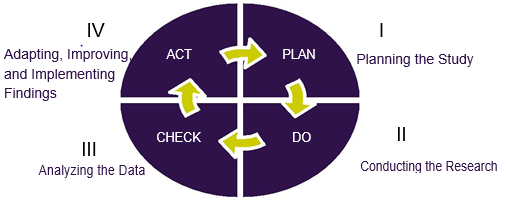Benchmarking in Project Management
(→Purpose of Benchmarking) |
(→Purpose of Benchmarking) |
||
| Line 15: | Line 15: | ||
As part of the benchmarking process, many models and approaches have been used but they all take into account an iterative benchmarking process proposed by W.E Deming called the “'''Deming cycle'''”. The Deming cycle includes a minimum of four phases “Plan –Do-Action-Check” and is presented in Figure 1. | As part of the benchmarking process, many models and approaches have been used but they all take into account an iterative benchmarking process proposed by W.E Deming called the “'''Deming cycle'''”. The Deming cycle includes a minimum of four phases “Plan –Do-Action-Check” and is presented in Figure 1. | ||
| − | + | [[File:Plan_do_check_act.PNG]]|upright=1.35 | |
==Types of Benchmarking== | ==Types of Benchmarking== | ||
Revision as of 15:16, 19 September 2015
Nowadays, project management tools and methodologies have been highly useful for organisations that seek to implement changes in order to increase their performance. Adding to that, organisations are constantly striving to find new opportunities to make it as much effective for them as possible. One of these opportunities is to examine the outcomes and the lessons learnt from various similar projects that have been completed in the market from similar organisations and thus use benchmarking.
As a business term, benchmarking is the series of actions in order to compare one's business distinct processes, practices or procedures, to other businesses that perform similar activities and have a leading role in the world market. Benchmarking is mainly used so that the company gains valuable information in pursuance of improving its performance and, as a natural outcome, to increase its competitiveness. Usually, there are different indicators that companies use to assess their performance during the process of benchmarking that mainly focus on the aspects of time, cost and quality.
It has been proved that benchmarking against companies that have a leading role in the industry has effectively helped average organizations to improve their performance [2]. Based on that, this article will present how improvements in the performance of companies can be achieved by benchmarking projects. This article will firstly explore the general purpose of benchmarking. Then, it will be examined how the distinct types of benchmarking can be applied to the management of projects. Furthemore, there will be a discussion on what to benchmark and what aptitudes are needed to do so. Finally, an analysis about the limitations of benchmarking in project management will be held.
Contents |
Purpose of Benchmarking
Benchmarking is a constant process of analysis and research of the best performers in order to extrude useful information for improving the organisational or project performance of a company, and not just copy or imitate what others do to thrive. As Bent and Humphrey suggest about benchmarking, ‘‘Benchmarking is the technical core of the Total Quality Management (TQM) process. It identifies the quality of current personal skill levels and company procedures/methods, and then compares this quality with the latest state-of-the-art techniques’’ [3].
Another definition of benchmarking was suggested from the International Benchmarking Clearinghouse (IBC) Design Steering Committee which concluded in 1992 that benchmarking is: “A systematic and continuous measurement process; a process of continuously measuring and comparing an organisation’s business processes against business process leaders anywhere in the world to gain information which will help the organisation take action to improve its performance [4].”
It is clear from these definitions that benchmarking is not only a process in which performance, compared to others, can be measured, but also a tool to describe how notable performance can be accomplished. This kind of performance can be described by measures of performance indicators, called benchmarks. The activities that are used in order to achieve this performance are called enablers [5] and their main purpose is to analyze the logic for achieving this kind of notable performance. Usually, benchmarking studies are conducted with the support of this two components and thus it can be stated that benchmarks can be attained by obtaining enablers.
As part of the benchmarking process, many models and approaches have been used but they all take into account an iterative benchmarking process proposed by W.E Deming called the “Deming cycle”. The Deming cycle includes a minimum of four phases “Plan –Do-Action-Check” and is presented in Figure 1.
